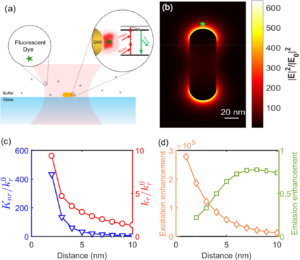Xuxing Lu and Deep Punj are working on this project.
Gold nanoparticles (GNPs), such as gold nanorod (GNRs), are well known for their facile synthesis and unique plasmonic properties. The strong interaction of GNRs with resonant light induces collective oscillations of the metal electrons and strongly confines the electromagnetic energy around the tips of the rods. The hot spot created at the tip of a GNR or within the gap of GNR dimers provides electric field enhancement (Figure 1b) that in turn enhances radiative and non-radiative emission. These interactions combine to enhance considerably the fluorescence of emitters placed in the hot spots (Figure 1c and 1d). As the plasmon resonance of GNRs can be tuned easily by adjusting their aspect ratio, and because of the strong electromagnetic confinement, GNRs are unique platforms to detect even very weak single emitters with high contrast.
In our project, we focus on GNR and GNR dimers to enhance fluorescence of very weakly emitting single molecules. We are interested in (i) enhancing the one-photon-excited (OPE) fluorescence of near-infrared fluorophores having very low quantum yield, and (ii) two-photon-excited (TPE) fluorescence from single molecules. TPE cross-sections are extremely low for conventional fluorescent molecules [1,2], which are hard to detect at the single-molecule level with single GNRs. We develop new protocols to create end-to-end GNRs assemblies and to detect single weak emitters in the generated hot spots.

Figure 1: (a) Schematic of a fluorophore interacting with the hot spot of a GNR under two-photon excitation (b) Calculated near-field intensity map of a 38 nm×114 nm nanorod in water (surface plasmon resonance at 775 nm) (c) Calculated radiative rate enhancement (kr/kr0, red circles, right axis) and relative additional non-radiative rate (Knr/kr0, blue triangles, left axis) of an emitter as functions of the distance to the tip of the nanorod (d) Calculated excitation enhancement (orange diamonds) and emission enhancement (green squares) as functions of the distance to the tip of the nanorod. [3, 4]
[1] W. Denk, J. H. Strickler, and W. W. Webb, “Two-photon laser scanning fluorescence microscopy,” Science, vol. 248, no. 4951, pp. 73–76, 1990.
[2] A. Diaspro and G. Chirico, “Two-photon excitation microscopy,” Advances in Imaging and Electron Physics, vol. 126, pp. 399–429, 2003.
[3] W. Zhang, M. Caldarola, X. Lu, and M. Orrit, “Plasmonic Enhancement of Two-Photon-Excited Luminescence of Single Quantum Dots by Individual Gold Nanorods,” ACS Photonics, vol. 5, no. 7, pp. 2960–2968, 2018.
[4] W. Zhang, M. Caldarola, X. Lu, B. Pradhan, and M. Orrit, “Single-molecule fluorescence enhancement of a near-infrared dye by gold nanorods using DNA transient binding,” Physical Chemistry Chemical Physics, vol. 20, no. 31, pp. 20468–20475, 2018.


